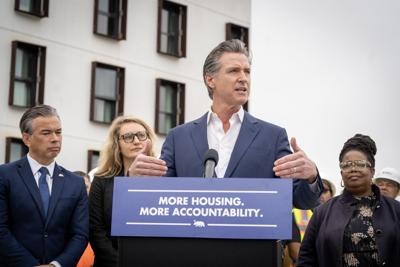
California Gov. Gavin Newsom speaks at a signing event for a package of housing bills on Sept. 19 in San Francisco. Photo courtesy the Office of the Governor.
No deficits. A “modest” surplus of $363 million. Almost $17 billion more in revenue than planned.
Gov. Gavin Newsom’s office laid out its vision today for how California should spend its considerable bounty, a total budget of $322 billion — projected to be the second largest state spending plan ever.
It released the proposal — on the date required by law — at a moment of deep uncertainty with devastating fires continuing to burn in Los Angeles County and President-elect Donald Trump preparing to take office this month. Those developments could require significant changes to Newsom’s plan before he finalizes the state budget in late June.
The economic impact of the ongoing Los Angeles-area fires alone is estimated to be at least $135 billion. That’s based on damage caused to homes, cars, businesses and lost economic activity, said Dan DePodwin, senior director of forecasting operations at AccuWeather. A spokesperson for the Governor’s Office of Emergency Services said it’s too soon to calculate the cost of the fires to the state.
Trump, meanwhile, has repeatedly threatened to withhold federal disaster aid from California, which is facing one of its most destructive wildfires this week. While outgoing President Joe Biden has approved Newsom’s request for a major disaster declaration — allowing the state to tap into federal funding and assistance programs — the state could still need more federal disaster funding under Trump’s administration.
“The bottom could completely fall out,” Newsom said in a preview of his budget proposal earlier this week.
Nonetheless, the fiscal outlook is far rosier than the pall that hung over California last year when lawmakers and the governor scrambled to plug a more than $46 billion budget hole. In June, they struck a deal to cut $16 billion in spending, delay another $3 billion in funding for various services and draw a total $12 billion from the state’s rainy day fund for two fiscal years.
Now, the administration projects the state budget’s main tranche of cash, the general fund, will rise to $229 billion in 2025-26. That’s about $10 billion more than what his office and lawmakers predicted last June and roughly $17 billion more than what’s in this year’s budget.
But Newsom’s also sticking to last year’s deal with the Legislature to pull $7.1 billion from the state’s main reserve account — even though his office projected on Monday that revenues are up by $16.5 billion more than planned across a three-year budget window.
Sen. Roger Niello, a Republican representing Roseville, criticized Newsom’s plan to continue drawing from reserves.
“We’re talking about increased revenues and a relatively strong economy, and yet we have to pull from reserves, which doesn’t make sense to a lot of people,” said Niello, the top Republican on the Senate budget committee. “And it also kind of doesn’t make sense that you’re talking about actually having a surplus when you had to pull from the reserves to create that surplus.”
New homeless agency, free diapers
Those conditions allowed Newsom to make several new proposals, including creating a state agency to better coordinate homelessness and housing policies. The administration did not propose new spending on homelessness, and it did not release details on how it would reorganize existing departments under the agency Newsom envisions.
Finance Director Joe Stepenshaw said the spending plan proposes just $1.2 billion in new funding. “There is very limited new commitments in this budget,” he said.
Most state revenue comes from personal income tax
The personal income Californians pay accounts for about 60% of money that goes toward the state's general fund. Corporate taxes as well as sales and use taxes make up another third.
In a small item that could make a meaningful difference to new parents, Newsom wants to spend $7.4 million to provide a three month supply of diapers for newborns. He also seeks to add $40 million in funds for schools to screen students for reading difficulties, including dyslexia.
Newsom also wants to add 700 firefighters next fiscal year, bringing the total number of firefighters almost 10,000. Cal Fire had about 5,800 firefighters just seven years ago. The state has been increasing their headcount because of the growing intensity of California wildfires to accommodate contract changes that are meant to give firefighters better schedules.
And, voters gave Newsom more flexibility last year when they approved three substantial bonds, which allow the state to borrow money and repay it over time.
As a result, the budget includes $2.7 billion in new climate spending stemming from Proposition 4; $8.5 billion for school facilities thanks to Proposition 2; and $6.4 billion for mental health housing from Proposition 1.
Lower spending on prisons, tight budgets for UC and Cal State
Still, the balanced budget rests on proceeding with cuts to many state programs that Newsom and the Legislature agreed to last June, including a 7.95% cut in operational budget to nearly all state agencies.
Newsom said earlier this week that his administration has been tightening spending, including by eliminating 6,500 vacant positions. By eliminating those positions, the state saves $1.2 billion, Newsom said.
The administration also projects lower spending in state prisons even though it expects California’s incarcerated population to increase in the short term because of the sentencing changes voters approved when they passed Proposition 36 in November. Newsom’s budget would cut corrections spending by $400 million, bringing it down to $13.6 billion.
Most of the cuts took hold last summer, but Newsom is going forward with slashing state support to the University of California and California State University by nearly 8% in 2025-26 — a combined hit of $772 million.
“Larger class sizes, fewer course offerings and a reduced workforce will hinder students’ ability to graduate on time,” said Cal State’s chancellor, Mildred Garcia, in a statement.
For UC, the cuts and delays mean that the system will end up with $400 million more in state support in 2027-28 than it got in 2023-24. Ongoing increases to tuition also will bring in more money. But, with growing labor and academic costs to teach its students of roughly half a billion dollars annually, the UC told CalMatters that it expects to see a revenue shortfall of more than $700 million in 2027-28.
“I am disappointed reductions have been proposed in both the University of California and California State University budgets. We will explore ways to restore these cuts, particularly to the CSUs,” said John Sen. Laird, the Santa Cruz Democrat who is the chairperson the budget committee that oversees education spending.
Student financial aid remains mostly untouched in the budget plan. The state’s flagship tuition waiver program, the Cal Grant, remains unscathed — a $2.6 billion behemoth benefiting more than 400,000 students.
Public K-12 education and community colleges would be fully funded under Newsom’s proposal. Newsom intends to proceed with fully funding the state’s expanded early education programming, transitional kindergarten, to all eligible 4-year-olds. His budget would mean the second largest amount of state support for K-12 and community colleges. About half of the state’s general fund supports education, and most of that flows to public K-12.
The proposed budget includes $100 million in new money to help community colleges provide students with course credit for prior work experience. The end goal in his master plan for career education is to overhaul the state’s convoluted job training programs.
Asking voters to put more money in reserves
Newsom’s budget proposal includes $17 billion in reserves. But, he cautioned, the state may decide to set aside more money because of the economic uncertainty his administration anticipates from Trump’s trade and immigration policies.
That’s partly why his office wants to raise the cap on how much money the state can deposit to its rainy day fund. As a result of Proposition 2 — a ballot measure approved by voters in 2014 — the state is required to make deposits until the balance reaches 10% of the state’s general fund tax revenue.
During the budget presentation, Stephenshaw said Newsom wants to up the limit to 20%. That change would require voters to pass a ballot measure allowing it.
“This will enable us to save a lot more during the upswings and be able to provide a more stable management of our funds going forward to protect the programs and services that the Californians rely upon,” Stephenshaw said.











(0) comments
Welcome to the discussion.
Log In
Keep it Clean. Please avoid obscene, vulgar, lewd, racist or sexually-oriented language.
PLEASE TURN OFF YOUR CAPS LOCK.
Don't Threaten. Threats of harming another person will not be tolerated.
Be Truthful. Don't knowingly lie about anyone or anything.
Be Nice. No racism, sexism or any sort of -ism that is degrading to another person.
Be Proactive. Use the 'Report' link on each comment to let us know of abusive posts.
Share with Us. We'd love to hear eyewitness accounts, the history behind an article.